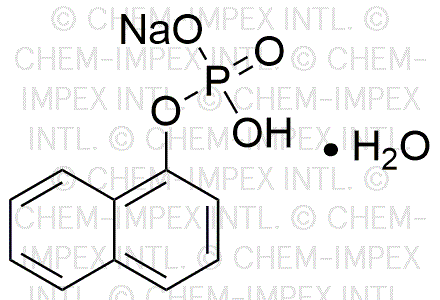1-Naphthyl phosphate sodium salt monohydrate is widely utilized in research focused on:
- Biochemical Assays: This compound serves as a substrate in enzyme assays, particularly for phosphatases, allowing researchers to study enzyme kinetics and inhibition effectively.
- Cell Culture Applications: It is used in cell culture media to promote cell growth and differentiation, especially in studies involving neuronal cells, enhancing the understanding of cellular processes.
- Drug Development: The compound plays a role in the screening of potential drug candidates by providing a model for studying drug interactions with phosphatase enzymes, which are crucial in various metabolic pathways.
- Environmental Studies: It can be utilized in assessing the impact of pollutants on aquatic life, as it helps in understanding the biochemical pathways affected by environmental toxins.
- Analytical Chemistry: This chemical is employed in the development of analytical methods for detecting phosphatase activity in biological samples, offering a reliable approach for researchers in biochemistry.
General Information
Properties
Safety and Regulations
Applications
1-Naphthyl phosphate sodium salt monohydrate is widely utilized in research focused on:
- Biochemical Assays: This compound serves as a substrate in enzyme assays, particularly for phosphatases, allowing researchers to study enzyme kinetics and inhibition effectively.
- Cell Culture Applications: It is used in cell culture media to promote cell growth and differentiation, especially in studies involving neuronal cells, enhancing the understanding of cellular processes.
- Drug Development: The compound plays a role in the screening of potential drug candidates by providing a model for studying drug interactions with phosphatase enzymes, which are crucial in various metabolic pathways.
- Environmental Studies: It can be utilized in assessing the impact of pollutants on aquatic life, as it helps in understanding the biochemical pathways affected by environmental toxins.
- Analytical Chemistry: This chemical is employed in the development of analytical methods for detecting phosphatase activity in biological samples, offering a reliable approach for researchers in biochemistry.
Documents
Safety Data Sheets (SDS)
The SDS provides comprehensive safety information on handling, storage, and disposal of the product.
Product Specification (PS)
The PS provides a comprehensive breakdown of the product’s properties, including chemical composition, physical state, purity, and storage requirements. It also details acceptable quality ranges and the product's intended applications.
Certificates of Analysis (COA)
Search for Certificates of Analysis (COA) by entering the products Lot Number. Lot and Batch Numbers can be found on a product’s label following the words ‘Lot’ or ‘Batch’.
Numéro de catalogue
Numéro de lot/série
Certificates Of Origin (COO)
This COO confirms the country where the product was manufactured, and also details the materials and components used in it and whether it is derived from natural, synthetic, or other specific sources. This certificate may be required for customs, trade, and regulatory compliance.
Numéro de catalogue
Numéro de lot/série
Safety Data Sheets (SDS)
The SDS provides comprehensive safety information on handling, storage, and disposal of the product.
DownloadProduct Specification (PS)
The PS provides a comprehensive breakdown of the product’s properties, including chemical composition, physical state, purity, and storage requirements. It also details acceptable quality ranges and the product's intended applications.
DownloadCertificates of Analysis (COA)
Search for Certificates of Analysis (COA) by entering the products Lot Number. Lot and Batch Numbers can be found on a product’s label following the words ‘Lot’ or ‘Batch’.
Numéro de catalogue
Numéro de lot/série
Certificates Of Origin (COO)
This COO confirms the country where the product was manufactured, and also details the materials and components used in it and whether it is derived from natural, synthetic, or other specific sources. This certificate may be required for customs, trade, and regulatory compliance.


